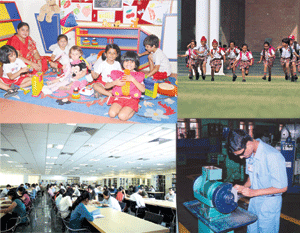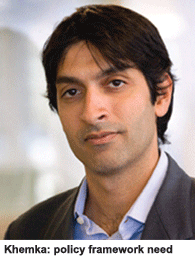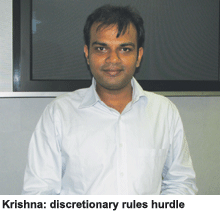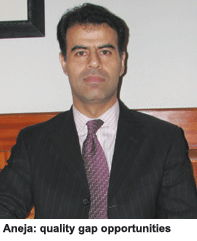Rising public clamour for private pre-school, K-12, vocational and higher education has created huge investment and business opportunities for venture capital funds, education entrepreneurs as well as for charitable trusts, NGOs and philanthropists. Dilip Thakore reports
 Investors in India and around the world are reportedly readying huge resources for deployment into India’s education sector — the world’s largest and most under-served market for pre-school, K-12, vocational and higher education. According to finance industry sources, more than 350 private equity and venture capital firms in India are all set to invest a massive $10 billion (Rs.45,000 crore) in Indian education this fiscal.
Investors in India and around the world are reportedly readying huge resources for deployment into India’s education sector — the world’s largest and most under-served market for pre-school, K-12, vocational and higher education. According to finance industry sources, more than 350 private equity and venture capital firms in India are all set to invest a massive $10 billion (Rs.45,000 crore) in Indian education this fiscal.
Decades of under-funding, neglect of the government-managed public education system, and imposition of a rigid licence-permit-quota regimen over private initiatives across the education continuum has generated a huge pent-up demand for qualitatively superior privately-provided education across the board. In particular, with the country’s 294,862 recognised private, including 175,885 unaided (financially independent) primary, secondaries and higher secondaries, which together constitute a mere 23 percent of schools countrywide hosting 90 million children bursting at the seams, rising public clamour for private K-12 education has created huge investment and business opportunities for venture capital funds, education entrepreneurs as well as for charitable trusts, NGOs and philanthropists.
In the higher education sector heavily dominated by Central and state govern-ment institutions, decades of under-investment and over-subsidisation of tuition has created acute demand-supply imbalances, prompting over 120,000 next-best students denied admission into the much-too-few high-quality colleges and universities to migrate every year to higher education institutions abroad, especially American universities. This annual exodus costs them an estimated $3.9 billion (Rs.17,500 crore) per year. Moreover according to a McKinsey World Institute-NASS-COM study (2005), over 85 percent of science, arts and commerce and 75 percent of engineering graduates churned out by India’s 509 universities and 31,000 colleges are unqualified for employment in globally bench-marked companies.
Consequently despite the myriad requirements of the licence-permit-quota regimen imposed upon private initia-tives, excellent private higher education institutions such as Manipal, Amity, NIIT and VIT among other universities, have struck root in inhospitable Indian soil. Simultaneously several private colleges of professional education (medicine, engineering, business and hospitality management) have also established excellent reputation and offer globally comparable tuition at arguably the lowest (unsubsidised) prices worldwide.
Little wonder that with hardly a handful of the country’s 1.09 million government schools, 509 universities and 31,000 colleges delivering globally comparable education, public demand for private education is growing. “India’s education and training sector offers private institutions an estimated $40 billion (Rs.180,000 crore) market, with a potential 16 percent five-year CAGR (compounded average growth rate),” says a 2008 survey report of CLSA Asia Pacific Markets, a highly respected Hong Kong-based market research and brokerage firm. According to this detailed report which estimates private spending in 25 segments of the education continuum from K-12 to professional undergraduate and postgrad education, aggregate private expenditure on education across the spectrum will rise to $68 billion (Rs.300,000 crore) in 2012 (see table userfiles/Table-Private education.pdf).
Likewise a study conducted by the Mumbai-based Infrastructure Develop-ment Finance Co and SSKI (an invest-ment bank “with a strong research bias”) also indicates that India’s fast-expanding middle class is willing and able to invest heavily in the education of its children. “With an inefficient public education system, a growing young population, a burgeoning middle class (with the intent and ability to spend) and price discovery... we expect a 14 percent CAGR in private spends on education ($80 billion by 2012),” says the IDFC-SSKI report.
Indeed so manifest and overwhelming is public demand for quality private education, that “regulatory uncertainty” hasn’t deterred private equity firms and adventurous investors from attempting to secure early movers’ advantage in anticipation of liberalisation and deregulation of Indian education in the near future. According to Venture Intelligence, a division of the Chennai-based TJS Media Pvt. Ltd, during the period 2005-2008 private equity and venture capital investors made investments aggregating over $262 million (Rs.1,180 crore) in 32 private education — including training, e-learning, online tutoring, English language and vocational training, pre-schools and assessment services — among other companies. Writing in the Business Standard (February 3) Kalpana Pathak and Raghuvir Badrinath predict that private equity and venture investment in education is likely to double over 2009 this year, citing a Grant Thornton (a transnational accountancy firm with its headquarters in UK) report indicating that investment in private education in India rose from $35 million in 2008 to $108 million (Rs.486 crore) in 2009.
 “There is a huge volume of private capital waiting to enter Indian educa-tion, and higher education in particular, once the policy framework supported by clear rules and regulations relating to academic and administrative auto-nomy, and returns to investors, is formulated. To sustain its current annual rate of economic growth, India needs to increase the number of its higher education graduates by 7.7 million by 2014 which will require additional investment of Rs.77,000 crore, a sum which is beyond the investment capability of the Central and state governments. The flood of enquiries we get almost daily for aid and advice indicates there’s no shortage of philanthropists, trusts, NGOs and entrepreneurs ready and willing to invest in education, provided they are assured administrative autonomy and reasonable returns on investment,” says Karan Khemka, an alumnus of the blue-chip Georgetown (USA) and Cambridge (UK) universities and currently the Mumbai-based partner of the US-based consultancy Parthenon Group which bills its education advisory wing as “the largest by far worldwide”, and includes the Bill and Melinda Gates and Dell foundations as its clients.
“There is a huge volume of private capital waiting to enter Indian educa-tion, and higher education in particular, once the policy framework supported by clear rules and regulations relating to academic and administrative auto-nomy, and returns to investors, is formulated. To sustain its current annual rate of economic growth, India needs to increase the number of its higher education graduates by 7.7 million by 2014 which will require additional investment of Rs.77,000 crore, a sum which is beyond the investment capability of the Central and state governments. The flood of enquiries we get almost daily for aid and advice indicates there’s no shortage of philanthropists, trusts, NGOs and entrepreneurs ready and willing to invest in education, provided they are assured administrative autonomy and reasonable returns on investment,” says Karan Khemka, an alumnus of the blue-chip Georgetown (USA) and Cambridge (UK) universities and currently the Mumbai-based partner of the US-based consultancy Parthenon Group which bills its education advisory wing as “the largest by far worldwide”, and includes the Bill and Melinda Gates and Dell foundations as its clients.
Conterminously with enlightened investors and edupreneurs marshalling massive capital for investment in Indian education, a clutch of India’s most famous and celebrated lawyers are preparing to argue the case for liberal-isation and deregulation of K-12 education in Society for Private Unaided Schools of Rajasthan vs. Union of India (Writ Petition (C) No. 95 of 2010) in the Supreme Court. A positive and progressive judgement of the court in this and several other writ petitions clubbed with it for hearing and adjud-ication by a five-judge bench of the country’s apex court and final arbiter, will open the floodgates for massive foreign and domestic investment in K-12 and higher education.
At issue in this historic battle brewing in the Supreme Court, is the constitut-ional legitimacy of the Right to Free and Compulsory Act, 2009 (aka Right to Education Act) and in particular some of its provisions which impose an admissions quota on the country’s 175,885 private unaided K-12 schools, besides several other duties and obligations imposed upon the petitioners which they contend abridges and/or infringes their fundamental right to engage in the ‘occupation’ of education provision (under article 19 (i) (g) of the Constitution), and to “establish and administer educational institutions of their choice” (Article 30 (1)).
Though the general expectation is that the apex court will smooth the way for private initiatives in K-12 education when it delivers its verdict in the Society for Private Unaided Schools of Rajasthan and clubbed cases, there is nevertheless a possibility that the five-judge bench could — in keeping with the traditions of the court which in the past has firmly set its collective face against the “commercial-isation of education” — deliver an ambiguous judgement replete with litigious terms and conditions. But even so, substantial and swelling inflows of private investment and initiatives in primary-secondary education are now unstoppable, given the overwhelming demand for quality education from all segments of Indian society.
Suddenly there is sharp awareness within the collective public mind — even if not within the lackadaisical offices of the Union HRD ministry and education ministries of the state governments — that quality education is the magic mantra to spare generation next the pains of poverty and deprivation which an entire generation of midnight’s children have had to endure. Moreover there is pervasive acceptance that government — especially state governments and local authorities — is not equipped to deliver the quality of school or higher education required by Indian industry or agriculture. This is evidenced by the accelerating phenomenon of the flight of children from even the poorest households countrywide into inexp-ensive ‘unrecognised’ private schools, as vividly recounted by Prof. James Tooley in his path-breaking book The Beautiful Tree (Penguin, 2009). Nor is this phenomenon confined to the informal K-VIII schools. Currently India’s 294,862 recognised private schools — a mere 23 percent of the country’s 1.28 million K-12 institutions — dispense superior learning to 38 percent (90 million) of India’s in-school population.
In all likelihood, based on the detailed ratio decidendi (reasoning) of the 11- judge bench of the apex court in T.M.A Pai Foundation vs. Union of India & Ors (2002) (8 SCC 481) and of a five-judge bench in Inamdar’s Case (2005) (6 SCC 537), the five-judge bench of the Supreme Court will uphold the fundamental right of the petitioners to manage private independent schools with minimal government interference in matters relating to admission of students of their choice, levying tuition fees and administering them to maintain teaching-learning standards.
Moreover, the general expectation within the legal fraternity and academic circles, is that the apex court will take “judicial notice” (acknowledge an obvious truth) of the dysfunctional condition of government-run schools and abolish the licence-permit-quota regime in Indian education, which vests vast arbitrary and discretionary powers in the Central and state governments to block promotion of greenfield schools and/or interfere with the management of existing independent K-12 institu-tions. Out of the litigation pending in the apex court, unambiguous terms and conditions under which private educa-tionists, trusts, NGOs and education entrepreneurs can establish and administer education institutions of their choice, is likely to emerge.
 “India’s need for conventional bricks and mortar, e-learning driven, vocational, supplementary and collegiate instit-utions right across the spectrum, is acute and growing. Our estimate is that if private investment and initiatives are modestly encouraged by government policy, middle class expenditure on K-12 education could triple from the current $20 billion to $60 billion (Rs.270,000 crore) within the next five years. Our research indicates that a large number of philanthropists and trusts in India and abroad are ready, willing and waiting to invest in Indian education if highly discretionary rules and regulations governing private education institutions are lifted and/or made transparent. Private investment is urgently needed in K-12 and higher education to improve the quality of education, and attract qualified teachers and faculty in institutions of higher education,” says S.K.C Krishna, an IIT-Madras and IIM-Calcutta alumnus and former Price Waterhouse and Indus Bank professional, who is currently closely monitoring the education sector in his capacity as director of the Mumbai-based firm MAPE (Mergers & Acquisitions and Private Equity).
“India’s need for conventional bricks and mortar, e-learning driven, vocational, supplementary and collegiate instit-utions right across the spectrum, is acute and growing. Our estimate is that if private investment and initiatives are modestly encouraged by government policy, middle class expenditure on K-12 education could triple from the current $20 billion to $60 billion (Rs.270,000 crore) within the next five years. Our research indicates that a large number of philanthropists and trusts in India and abroad are ready, willing and waiting to invest in Indian education if highly discretionary rules and regulations governing private education institutions are lifted and/or made transparent. Private investment is urgently needed in K-12 and higher education to improve the quality of education, and attract qualified teachers and faculty in institutions of higher education,” says S.K.C Krishna, an IIT-Madras and IIM-Calcutta alumnus and former Price Waterhouse and Indus Bank professional, who is currently closely monitoring the education sector in his capacity as director of the Mumbai-based firm MAPE (Mergers & Acquisitions and Private Equity).
The intensity of pent-up public demand for K-12 education is high-lighted by Dushyant Singh, the Mumbai-based director (strategic and comm-ercial intelligence) of the well-known management consultancy firm KPMG. In a paper written for Private Equity Pulse on Education, a study published by the Chennai-based TSJ Media Pvt. Ltd, Singh estimates the number of “premium private schools charging at least Rs.15,000 per year” at 30,000 country-wide with an aggregate enrolment of 36 million children. Arguing that the number of households with incomes of above Rs.300,000 per year will rise from 14 million currently to 64 million by 2014 — “a growth of nearly 400 percent” — Singh reckons that “there could be a requirement of around 45,000 additional schools in this category”.
With universal demand so pressing, these schools will be built, whether the judges of the Supreme Court smooth the way or not because it’s an open secret that there’s profit in school education, argues Singh. “Despite the fact that schools in India have traditionally been operated by non-profit bodies, operating a school can be a highly profitable business, and most premium schools operate at EBITDA (earnings before interest, tax, depreciation and amortization) of 40-50 percent or higher,” he writes.
.gif) Dushyant Singh’s enlightening paper merely confirms a well-known but seldom publicly acknowledged reality that the demand for qualitatively superior education across the board is so insistent that despite the ill-drafted legal restrictions imposed upon private education providers, edupreneurs have demonstrably and often legally beaten the regulatory system. “The for-profit education market is so under-served that one doesn’t need to do anything new, just keep growing the footprint. India can easily accommodate another ten Educomps,” said Shantanu Prakash, IIM-Ahmedabad alumnus and prom-oter-chairman of the Delhi-based Educomp Solutions Ltd, India’s pioneer ICT (information communications technology)-in education and arguably most successful company (market capitalisation: Rs.5,256 crore), in an interview to Business Standard (March 2009).
Dushyant Singh’s enlightening paper merely confirms a well-known but seldom publicly acknowledged reality that the demand for qualitatively superior education across the board is so insistent that despite the ill-drafted legal restrictions imposed upon private education providers, edupreneurs have demonstrably and often legally beaten the regulatory system. “The for-profit education market is so under-served that one doesn’t need to do anything new, just keep growing the footprint. India can easily accommodate another ten Educomps,” said Shantanu Prakash, IIM-Ahmedabad alumnus and prom-oter-chairman of the Delhi-based Educomp Solutions Ltd, India’s pioneer ICT (information communications technology)-in education and arguably most successful company (market capitalisation: Rs.5,256 crore), in an interview to Business Standard (March 2009).
Indeed even to the casual observer of the Indian education scene, it should be quite obvious that with the help of expert legal advice and the (wrongly) celebrated Indian entrepreneurs’ penchant for the jugaad (can-do, any which way) style of management, privately-promoted pre-schools, K-12 schools and colleges of professional education are prospering and multiplying. It’s hardly a secret that profits can be — and are — earned by enterprising edupreneurs through the simple expedient of establishing insti-tution management companies which provide a plethora of services to K-12 schools (and other not-for-profit education institutions) levying fees for each service — estate and infrast-ructure management, teacher recruit-ment, purchasing, marketing etc. Through this perfectly legal expedient, education management companies earn handsome surpluses which are deployed to promote greenfield institutions and build school and college chains.
Clearly the public tacitly approves the growth and multiplication of private schools. Despite private schools constituting a mere 23 percent of the country’s 1.28 million primary-secondaries (and their number could be much less because government statistics list primaries, secondary and higher secondaries within composite schools separately), they educate over 40 percent (90 million) of the country’s in-school children. And according to several studies, as many as 20 percent of rural in-school students are enroled in private schools.
 The view that an across-the-board investment boom in Indian education is imminent and inevitable is also shared by Sandeep Aneja, an alumnus of Stanford Business School and currently managing director of Mumbai-based Kaizen Private Equity, a division of the Kaizen Management Advisors Pvt. Ltd. “As huge as the demand-supply gap is the quality gap in school education. This reality has opened up a great opportunity in the schools accredit-ation and quality improvement businesses. The dominant need of K-12 institutions is new user-friendly technologies, improved curriculums, vocational education inputs and teacher training and development services. In particular there are great opportunities for promotion of private teacher training colleges and creating new career paths and structures for teachers, so that the country’s best and most idealistic graduates are attracted to the teaching profession. All this is possible within the framework of reasonable, Gandhian profits. But liberalisation and dereg-ulation of K-12 education is a necessary pre-condition of quality-conscious firms entering Indian education. I am confident that the judiciary will take note of the ground realities of Indian education and decree liberalisation,” says Aneja.
The view that an across-the-board investment boom in Indian education is imminent and inevitable is also shared by Sandeep Aneja, an alumnus of Stanford Business School and currently managing director of Mumbai-based Kaizen Private Equity, a division of the Kaizen Management Advisors Pvt. Ltd. “As huge as the demand-supply gap is the quality gap in school education. This reality has opened up a great opportunity in the schools accredit-ation and quality improvement businesses. The dominant need of K-12 institutions is new user-friendly technologies, improved curriculums, vocational education inputs and teacher training and development services. In particular there are great opportunities for promotion of private teacher training colleges and creating new career paths and structures for teachers, so that the country’s best and most idealistic graduates are attracted to the teaching profession. All this is possible within the framework of reasonable, Gandhian profits. But liberalisation and dereg-ulation of K-12 education is a necessary pre-condition of quality-conscious firms entering Indian education. I am confident that the judiciary will take note of the ground realities of Indian education and decree liberalisation,” says Aneja.
Quite clearly after decades of neglect and muddling through, Indian school and higher education is on the threshold of a renaissance. Suddenly there is intense awareness that the country’s 1.28 million K-12 schools and 31,000 colleges are not parking lots to keep children and youth out of trouble and mischief, but development institutions which should deliver real, measurable learning outcomes to prepare students for higher education and the shop-floors of Indian industry. Simultaneously there’s a chilling new awareness within Indian society that in the rapidly crystallising globalised world, generation next will have to compete for jobs and markets with their counterparts in the US, China and European nations which accord highest priority to development of human capital through continuously improving education systems and processes.
Against this challenging backdrop, there are great expectations that their lordships of the Supreme Court hearing counsels’ arguments in the landmark Society for Private Unaided Schools of Rajasthan Case, will take judicial notice of clearly expressed public preference for private education — increasingly available at all price points — and decree the liberalisation and deregulation of Indian education and K-12 education, in particular. With the licence-permit-quota regimen having demonstrably failed Indian education as it failed Indian industry until the historic liberalisation initiative of July 1991, the public interest demands this beneficial initiative is replicated in Indian education.